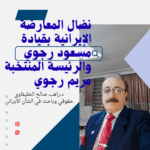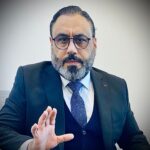إيران المستقبل: الجمهورية الديمقراطية بقيادة المقاومة المنظمة
بقلم د. راهب صالح الخليفاوي
حقوقي وباحث في الشأن الإيراني
في خضم الانهيارات المتسارعة التي يشهدها نظام ولاية الفقيه في إيران ومع اتساع رقعة الغضب الشعبي والانشقاقات داخل بنية النظام بات واضحًا أن البديل الديمقراطي ليس مجرد حلم بل مشروع حقيقي تقوده المقاومة الإيرانية منذ عقود وعلى رأسها المجلس الوطني للمقاومة الإيرانية برئاسة السيدة مريم رجوي
المجلس الوطني للمقاومة الإيرانية ليس تجمعًا سياسيًا عابرًا بل هو تجسيد لإرادة شعبية تعكس عمق الرفض الشعبي لنظام القمع والكبت والإعدامات تأسس المجلس في 1981 كبديل ديمقراطي للنظام الحاكم وضَمَّ في صفوفه شخصيات مستقلة ومثقفين وسياسيين ومنظمات تمثل مختلف أطياف المجتمع الإيراني واضعًا نصب عينيه هدفًا واضحًا بناء إيران حرة غير نووية قائمة على فصل الدين عن الدولة وتحترم حقوق الإنسان والمساواة بين المرأة والرجل
وفي طليعة هذا النضال تبرز السيدة مريم رجوي الرئيسة المنتخبة للمجلس الوطني للمقاومة الإيرانية كرمز للثبات والرؤية السياسية قدّمت رؤية من عشر نقاط لمستقبل إيران تتضمن الديمقراطية والتعددية السياسية واستقلال القضاء وحرية التعبير وحقوق الأقليات ورفض الإعدام والتعذيب مما يجعل هذه الرؤية حجر الأساس لجمهورية إيران الديمقراطية القادمة
لم تقف السيدة رجوي عند حدود المعارضة النظرية بل تحولت إلى صوت عالمي للمضطهدين في إيران كانت خطاباتها في البرلمانات الأوروبية والأمم المتحدة وفي الملتقيات الدولية بمنزلة خارطة طريق واضحة المعالم تكشف جرائم النظام وتقدم البديل الواقعي المدعوم من الداخل الإيراني ومن الشتات
إن ما يميز هذه المقاومة هو أنها ليست حركة معزولة بل حركة منظمة تمتد جذورها إلى الداخل الإيراني حيث الخلايا الشبابية المنتفضة التي تنشر شعارات إسقاط النظام في شوارع طهران وأصفهان ومشهد ولعلّ أبرز دليل على جدّية هذا التهديد للنظام هو تصعيده غير المسبوق في الإعدامات الجماعية ومحاولاته الإرهابية المتكررة لاستهداف تجمعات المعارضة في أوروبا
إن جمهورية إيران الديمقراطية القادمة بقيادة المجلس الوطني للمقاومة الإيرانية ليست خيالًا سياسيًا بل مشروعًا تتلاقى حوله طموحات شعبٍ يرزح منذ أربعة عقود تحت القهر ويتطلع إلى غدٍ يُحكم فيه بالصندوق وليس بالرصاص وبالدستور لا بالمرشد
ومن موقعنا كحقوقيين وباحثين فإن دعم هذا المشروع الوطني التحرري لا يُعد خيارًا سياسيًا فقط بل واجبًا أخلاقيًا وإنسانيًا في وجه أحد أكثر الأنظمة قمعًا في العصر الحديث
The Future Iran: The Democratic Republic Led by the Organized Resistance
By Dr. Rahib Salih Al-Khalifawi
Legal Expert and Researcher on Iranian Affairs
Amid the accelerating collapse of Iran’s Velayat-e Faqih (Guardianship of the Jurist) regime, and with the growing wave of popular outrage and internal defections within the system, it has become clear that the democratic alternative is no longer a distant dream but a genuine project—one that has been led for decades by the Iranian Resistance, particularly the National Council of Resistance of Iran (NCRI) under the leadership of President Maryam Rajavi.
The NCRI is not a fleeting political coalition but the embodiment of a popular will that reflects the deep-rooted rejection of a regime of repression, censorship, and executions. Established in 1981 as a democratic alternative to the ruling regime, the Council brings together independent figures, intellectuals, politicians, and organizations representing various segments of Iranian society. Its clear goal is to build a free, non-nuclear Iran founded on the separation of religion from the state and the respect for human rights and gender equality.
At the forefront of this struggle stands Mrs. Maryam Rajavi, the elected President of the NCRI, as a symbol of resilience and political vision. She has outlined a ten-point plan for Iran’s future, encompassing democracy, political pluralism, judicial independence, freedom of expression, minority rights, and the rejection of capital punishment and torture. This vision serves as the cornerstone for the future Democratic Republic of Iran.
Mrs. Rajavi has not confined herself to theoretical opposition but has become a global voice for the oppressed in Iran. Her speeches in European parliaments, the United Nations, and international forums have served as a clear roadmap—exposing the crimes of the regime while offering a viable and internally supported alternative, both from within Iran and across the diaspora.
What distinguishes this resistance is that it is not an isolated movement but a well-organized one with deep roots inside Iran. Youth cells rise up across the country, spreading slogans demanding the overthrow of the regime in the streets of Tehran, Isfahan, and Mashhad. Perhaps the most telling evidence of how seriously the regime views this threat is its unprecedented escalation in mass executions and its repeated terrorist attempts to target opposition gatherings in Europe.
The upcoming Democratic Republic of Iran, led by the NCRI, is not a political fantasy but a national project uniting the hopes of a people who have endured four decades of oppression—and who now aspire to be governed by ballots, not bullets, by a constitution, not by a Supreme Leader.
From our standpoint as legal professionals and researchers, supporting this national liberation project is not merely a political choice—it is a moral and humanitarian duty in the face of one of the most repressive regimes of the modern era.
